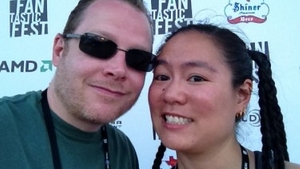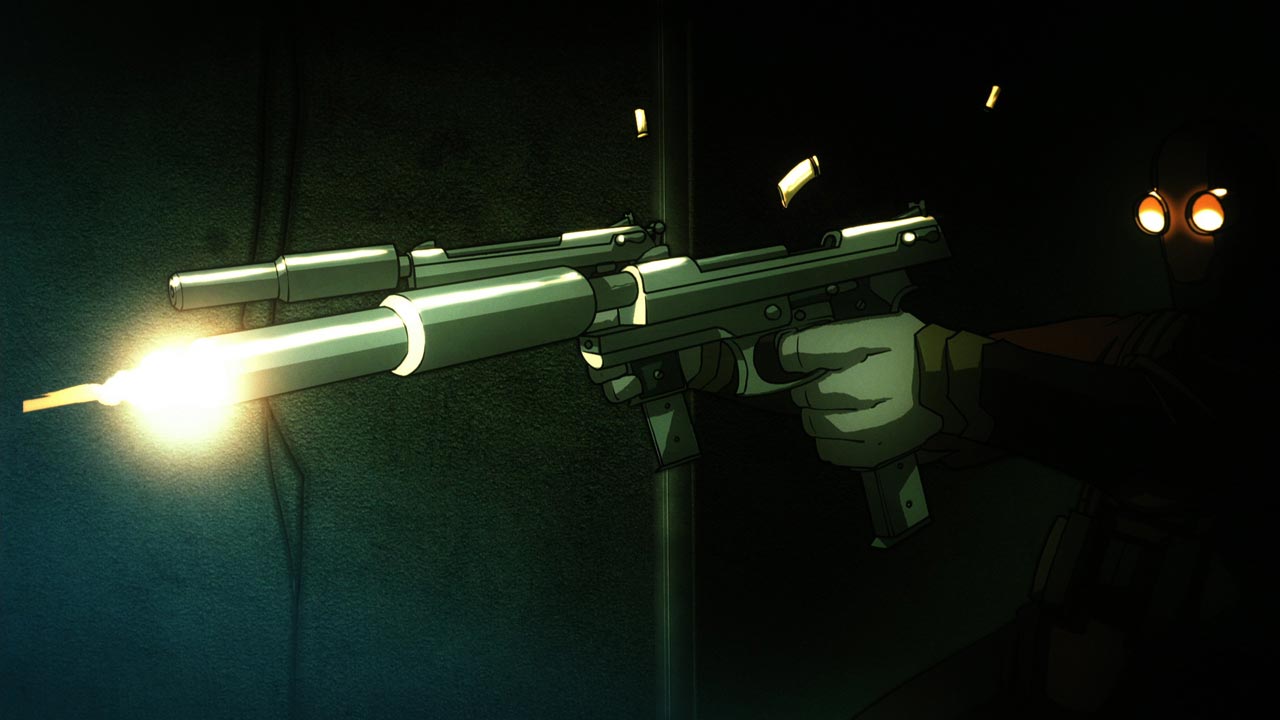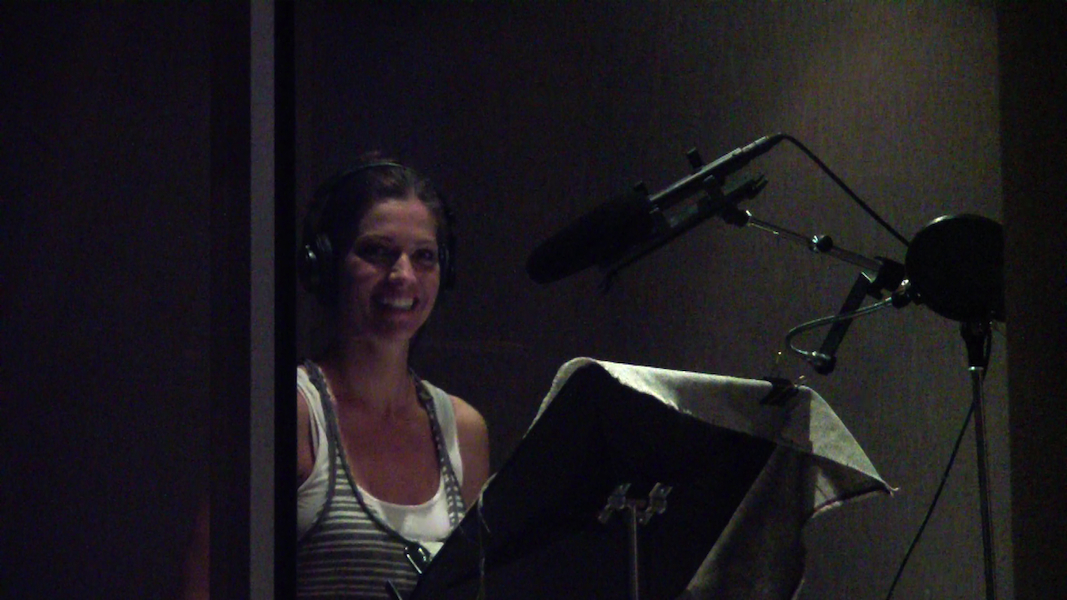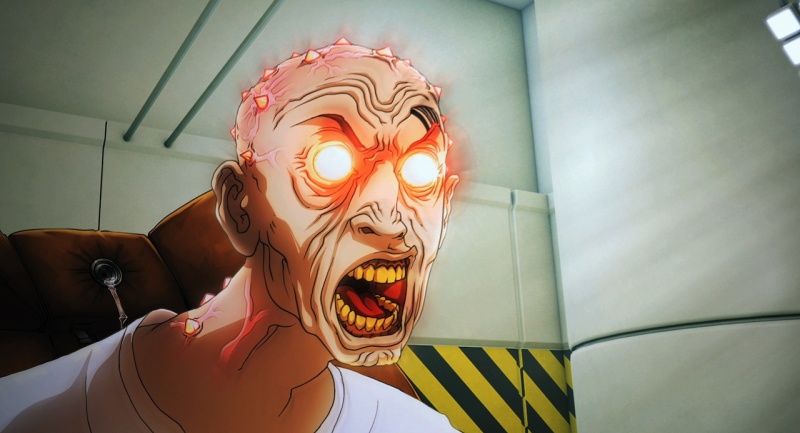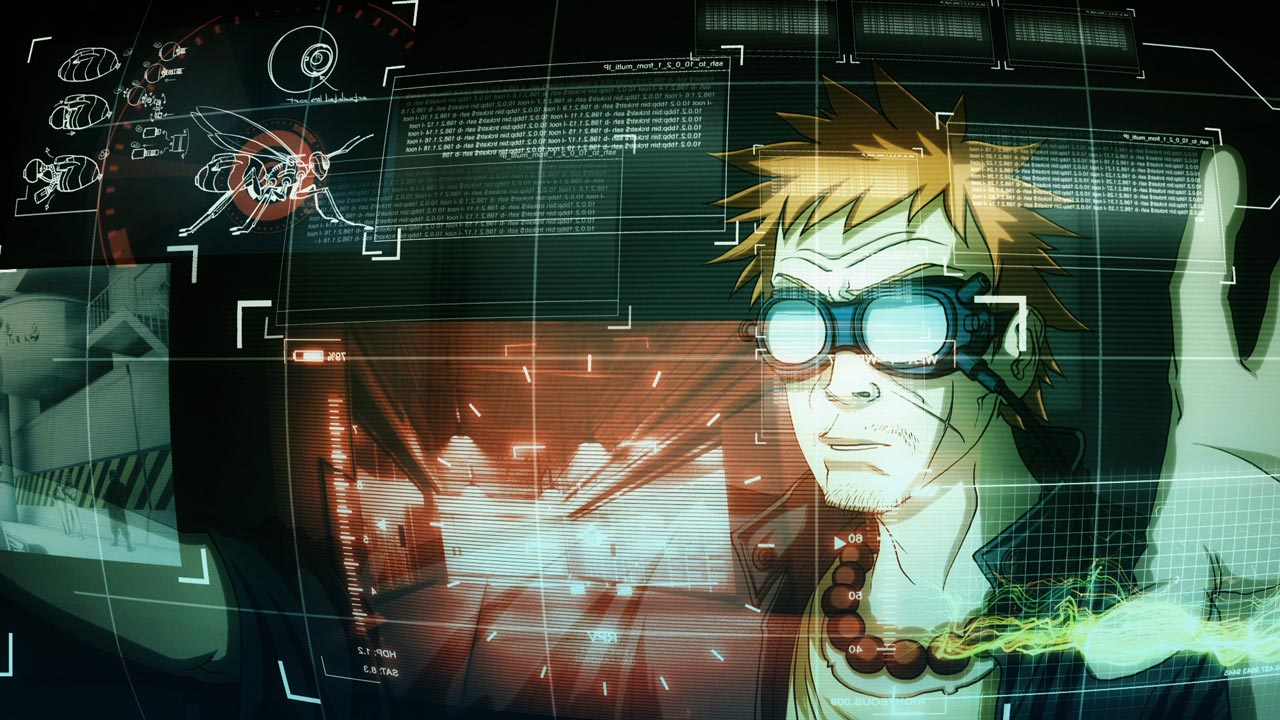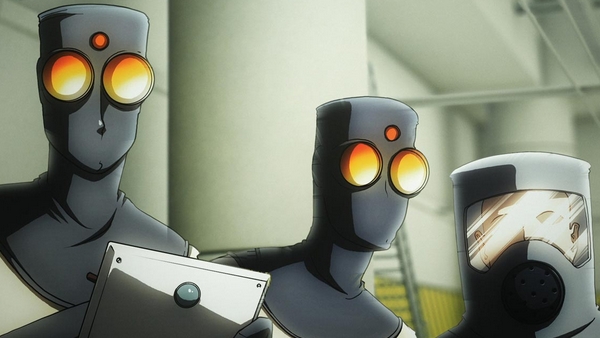
Editor’s Note: This interview took place at the 2012 Fantastic Fest in Austin, TX. It has been republished to coincide with the 2013 San Diego Comic Con where directors Cole Drumb and Jen Luk will be screening PostHuman.
Action anime isn’t something that American animation studios make all that often. Inspired by Akira and a slew of other seminal sci-fi titles, Jen Luk and Cole Drumb set out to create a modern rendition of what Heavy Metal was back in the 80’s. The duo has crammed so much awesome content into a 6 minute short that once you see PostHuman you will want to see so much more, trust us. Have a look at the short film here…fyi, this is NSFW.
Go,See,Talk sat with the directors (for the interview and a handful of screenings and drinks actually) and picked their brain about PostHuman. Here’s what they had to say about their baby.
—————————————————————————————————————————–
– Guys, this is like the 10th time we’ve hung out during the Fest and now we’re finally getting something recorded right?
*Both laugh*
– Well again I have to say this short is sensational, so let’s hear all about it. What inspired PostHuman?
CD: As huge fans of Heavy Metal we were looking for something that would feel like it would fit in seamless with a brand new vision of that film. So if there were a new generation of animated sequences our story would be one of those. That was one of our primary inspirations and then there’s Cronenberg’s Scanners, Akira and Jen’s favorite which is…
JL: Aeon Flux! It’s one of my very favorite series. Initially when we started PostHuman it was going to have no dialog like the original Aeon Flux shorts. The we decided it needed dialog and so we got Tricia Helfer which was awesome so I’m glad we ended up going in that direction.
– Yeah I saw that in the credits. How did you approach and attach various talents including Tricia for this?
CD: Well it started slow. We had the script and I had done a lot of sketches and we were at the second or third draft of the script which was about 22 pages and we finally found a storyboard artist named Tom Price who had a lot of the same interests and he ended up doing 500 storyboards.
JL: But that was for a 22 minute pilot episode…
CD: It was almost key-framed out and he would come to me with questions and we’d work story tweaks through our meetings. But his response to my requests was always “what the hell are you trying to do?” because as we got further in we kept taking things more and more extreme. But he was kind of bored with the work he was doing previously and this was his chance to really unleash his talents. When he first tarted working he would try to hide the violence in a corner or behind characters…
JL: And nudity was a little rough for him too…
CD: So yeah he would always ask us, “do you really want to show naked people?” And we kept saying just let go, this is not a commercial and that’s when he went crazy with it and drew those 500 boards. So we did rough animatics, with sounds and effects that matched what we wanted to do. After we talked to multiple multiple people they all told us cut it down to 10 minutes but we reedited it and cut it down to 6. Our next step was to find an animation company and we got exceptionally lucky with Humoring the Fates who made it look just awesome.
JL: From there we attracted Tricia Helfer, did the post, and got some great sound design. Bad Animals did a lot of good sound design and Neil Sanford Livingston did the score. We worked a lot with him because we were looking for something along the lines of hard rock/heavy metal with hard guitar riffs.
CD: But then Tron: Reconfigured came out and that’s all anyone was into and our composer was big into that too, he usually does a lot of electronic stuff. PostHuman has a lot of an electronic feel to it but we asked him to get more of the hard driving guitar element and he brought more of that into it.
– Well it definitely had that feel. Plus who doesn’t love Tron: Reconfigured? But what I want to know is when am I going to see more? Once PostHuman ended I wanted it to go on, especially if the angle you were going for with this segment would be to have it as part of a larger vehicle. But what stopped you from going further?
CD: Cash
JL: *laughs*
CD: *laughs* This is truly an independent production.
JL: We have day jobs and we funded everything ourselves, and we paid everybody who worked on it. We didn’t ask anyone to work for free and it was all on us, we had no financiers.
– Wow, a real labor of love then huh?
CD: Yeah, you’re betting on yourself which is always a tough gamble. For most people their biggest investment is their house…well we don’t have a house. Our car is 20 years old…you see what I mean?
JL: *laughs* We don’t even have a dog even though we would like to.
– So tell me more about your backgrounds, what did you two do before PostHuman?
CD: I was always into film, comics, all of the standard tropes for geeks. I could have easily been comic book guy on the Simpsons. *laughs* I grew up going to Comic-cons in Oklahoma and toyed with becoming a comic book artist/author, then looked looked at CG animation, I even worked for a games developer in
Seattle called Monolith Games and eventually ended up doing what I knew I wanted to do which was film.
JL: For me, growing up as a kid I was always into movies. But as a family we didn’t go out to movies quite that often and I grew up in a pretty small town that only had three theaters with one screen each but even so going to a movie was a major treat. Before the Internet, seeing a movie trailer on TV was always super exciting because they were rare to catch, you know? And I remember trying to stay up late to watch Siskel and Ebert because that was another one of the only times to be able to see movie trailers then so I’ve always been interested in films and trying to see as many as I can. And VHS helped with that but I just always wanted to see as much as I could.
CD: When did your parents take you to see Clockwork Orange?
JL: *laughs* My parents for some strange reason didn’t want to take me to the babysitter very often so they took me to some films when I was way too young so I think I saw Clockwork Orange when I was like 5 or 7 and my mom took me to see Animal House with her for some reason. I don’t know, it doesn’t seem like something my mom would be into but maybe because we had just moved to the states she was wanting to get into the American culture or something *laughs*. So I saw a lot of films that were not appropriate for me at the time but now I appreciate that experience even if at the time it was kind of freaking me out. From then on I stayed interested in film and then when I met Cole and found out that he was also doing some film work that’s when we started working together and here we are now.
– Perceptually speaking, when an audience sees a short they think “well that didn’t take very long to make right?” But you said it came down from 22 minutes to 5 and change. So what’s the production time for something as deceptively swift as PostHuman?
JL: Well it’s been pretty much 5 years now from when we first started so that means we were script-to-screen in 5 years. That included the storyboards and cutting and editing it down from the 22 minutes. The people we approached told us that we probably wouldn’t find a festival that would program a 22 minute “short” because the length isn’t optional for festival programming. So we got it to 10 then and were told that’s still too long and then finally landed on 6 minutes.
The whole process of finding an animation studio took a while too and the production time was probably a year and a half. The studio we used does a lot of commercial work so they were busy with other things but they worked on this simultaneously. Then once we got to editing that took about 6 months to a year as well, and sound design took a few months, as well as color correction and the voice work, which included working with Tricia and choosing the take we liked. that was tough because of of 20 takes we really liked all 20 takes.
CD: It was essentially like doing a feature film. All the elements were there, and you still have to do all those steps it was just that we ended up with a smaller final run time.
– One of the things that made me smile were the references and nods to anime you’re fond of. Yesterday we talked about Cowboy Bebop being influential and the Pierrot Le Fou episode jumped off the screen for me at least. What other nods did you throw in there that people may or may not notice?
CD: Well you’d probably have to see this as much as we have to catch all the references but there’s Pierrot Le Fou as you mentioned which we were thrilled to hear because that was definitely one of our favorite episodes and wanted to reference it. But in doing so we decided not to throw in the Pink Floyd kind of soundtrack, that kind of bubbles through Pierrot Le Fou. It’s a brilliant lab sequence in Cowboy Bebop and we told the animators at Humoring the Fates that we want the lab to be just blindingly white. You see something like Re-Animator, or…
JL: …or X-Files. You know, the shows and movies that all have these dark labs and medical facilities and we’re like, “come on, would it really be that dark?” You gotta see the stuff in a lab.
CD: So we almost washed it out and it worked out brilliantly and we think it’s awesome. We’re hoping people will think the same and wonder “yeah, why don’t other people do that with their labs?”. Also we’re a big fan of Michael Mann’s Heat and in Japan there’s a love of handling weapons properly so doing an anime we
wanted to have a weapon that was current and more importantly one that was handled properly. The animators went out and made sure they had the operational functionality right. It was a TAR 21 which was a very compact Israeli semi-automatic rifle.
JL: So it’s a real weapon but it kind of looks science fictiony.
CD: It’s a really cool gun where the long barrel has been put clear back to the butt stock so you can turn corners faster but it has the distance of an M-16 since the barrel is the same but it’s just not way out in front of you. But back to references, there are so many I’ll have to get you a list *laughs*
– Your lead animator was here at the screening. Did he do those 500 storyboards?
CD: No, he’s from Humoring the Fates.
JL: That was Ben McSweeney, our lead animator. But funny enough we only dealt with the owner of Humoring the Fates. We had never met with Ben before yesterday.
CD: So it was thrilling to see him. He actually did the facial animation and we didn’t know that so when we were talking to him he was like “oh yeah, that’s mine. I did that” And then we go, “Holy crap that’s awesome, Thank you!!”. He did a phenomenal job.
– Was Humoring the Fates the only animation company working on this and what kind of man power did they devote to PostHuman?
JL: On our giant list of credits for the animation team it was about 50 or 60 people.
CD: They’re based out of Florida. There are are very few animation studios here in the US and we met with a couple in Seattle as well as LA and I then I found the site for Humoring the Fates and started researching them. They do 2D as well as 3D which not many people do here anymore. It’s only 3D these days if they do animation at all.
JL: In the states…
CD: Yeah, in the states. So we had a reference DVD that had a lot of Blood: The Last Vampire for the liquid effects and Cowboy Bebop for things we liked and wanted to replicate and Heat for the gun play and we would send those out and have meetings with these people and say here’s what we want and here’s our animatic. Then those people would just go “wow! That is amazing!…and there’s no way we can afford to do something like this”. So we had people who we incredibly encouraging who said, “we can’t wait to see this when you get it done…but we can’t help you get from A to B”. So we sent it to Humoring the Fates, we got a call back from them and went “OK, Hell yes! We’re in!” So that was a thrill.
– This reminds me of The Animatrix where, likened to Heavy Metal, it is a group of shorts that tell a larger story from these various points of view. Now that you have this completed, have you met anyone who wants to help make that larger feature you were envisioning or an anthology that could become Heavy Metal 3.0?
CD: Yeah, we have had interest and been talking back and forth with quite a few different people. Everyone has their own ideas. The short answer is yes, but until something is signed and we start moving forward on whatever direction it will take we don’t know yet. We think that PostHuman is just starting to live so whatever form it takes next is unclear but yes we have had people talk to us about that.
I hear that Robert Rodriguez is working on the next Heavy Metal so if not PostHuman I would love to get my hands dirty playing around in the Heavy Metal universe and knock out another short. But my understanding is that you have Cameron, Spielberg, Zemeckis and all these heavy weights that want to do it too since they have been so influenced by it that they seem like they’ll be first in line.
– Well look what happened to someone like Neill Blomkamp, so you never know. But getting your name out there is the first step and PostHuman speaks for itself. So far the Press has seen it, Fantastic Fest guests have seen it, so when does the public see PostHuman?
CD: We’ll be showing it at Sitges, Spain next and then from there we’re still figuring it out and making the festival rounds. One day in the future we’ll put out a DVD because we have a lot of material from our planning stages we want to share, it’s just so cool. Like all the boards for the head grind sequence that I actually drew up myself. There’s about 47 of them that last about 5 to 10 seconds and it shows how I wanted it to happen with all the detail. It would also have the various scripts and sketches and things that made PostHuman what it is. Maybe we’ll go the download route but it will definitely be available very soon.
– Final thoughts. Have you ever thought about taking this in the direction of a video game? One of the many brilliant things the Wachowski’s did with The Matrix is to tell their story across different mediums. After The Matrix, there was Reloaded but leading to and including that story was the anime The Animatrix and the video game. Unless you watched and played it all, you didn’t get the whole story which is a really cool way of doing it.
CD: We just had a conversation with a video game designer inside. Video games are so grueling as compared to filmmaking. I worked for a video game company and I totally respect any video game designer. Now I’d love to do it and am happy to take PostHuman in any direction as long as it retains its integrity but we haven’t spoken to anyone specifically about that yet.
